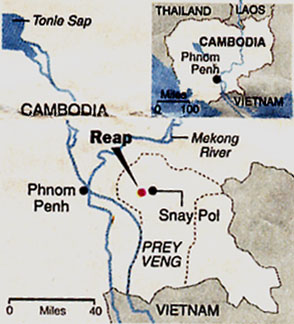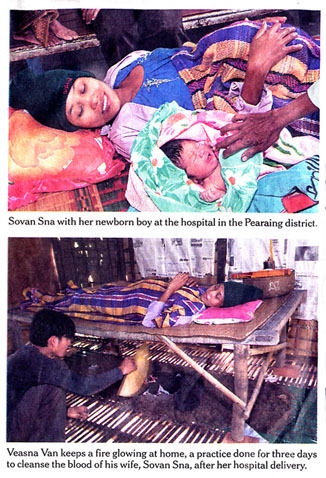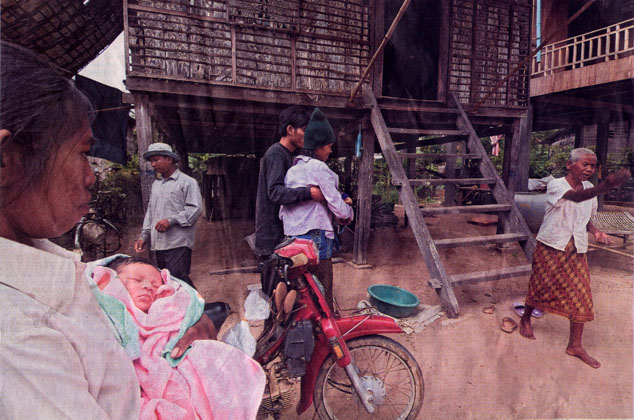
The right stuff: some third world governments are taking health care out of the hands of corrupt government officials and workers and putting it into the hands of international non-profit contractors.
| In the Pearaing district of Cambodia the main hospital, which in the past did not function due to corruption and minimal salaries, has been transformed, along with a growing segment of the nation's medical care, with help from international non-government organizations. Health Net International, of the Netherlands, led the way in Pearaing, paying doctors and nurses reasonable wages, among other measures, in an endeavor that includes funds from the World Bank, the Asian Development Bank, and the British government. Cambodian government funding that used to disappear into the trough of corrupt health care officials is now being delivered to the contractors that are part of the international effort. In the past, staff often pilfered supplies and practiced medicine elsewhere privately. Mother's of newborns sometimes had to pay bribes to see their babies without delay. Patients are now flocking to the new facilities, which charge 25 cents for a doctor visit, and 75 cents per day for hospital visits. (Not negligible sums where $1 a day is typical income.) |  |
Quote from article: "The approach is catching on in a growing number of poor countries around the world, from Bangladesh and Afghanistan to Congo and Rwanda, to Bolivia and Guatemala, reaching tens of millions of people. These contracted services have allowed international donors and concerned governments to cut through dysfunctional bureaucracies -- or work around them, and to improve health care and efficiency at modest cost."
The New York Times, Jan 8, 2006 pA8(L)
A Cure That Really Works: Cambodia Tries the Nonprofit Path to Health Care. (Foreign Desk) Celia W. Dugger.
Full Text: COPYRIGHT 2006 The New York Times Company
Sovan Sna had been in labor all night long. By the 16th hour of contractions, she was in trouble. The baby, her first, was not coming out. And she was so exhausted and in such pain she could barely speak. Her mind churned with fear. In the Khmer language, this most treacherous passage in a woman's life -- childbirth -- is called crossing the river. Her aunt had died giving birth to a first child who perished in the womb. Mrs. Sna wondered if she and her baby, too, would drown before reaching the other shore.
Not long ago, Mrs. Sna would have had little choice but to give birth at home, like her aunt, and risk both her life and her baby's. But on this morning, Mrs. Sna's terrified husband hired a pony cart and was able to take his wife over a deeply rutted dirt road to a small, no-frills public hospital. If childbirth is a miracle of nature, then the thriving, honestly run network of clinics and hospitals here is a human marvel, managed not by the government but by one of the nonprofit groups it has hired to run entire public health districts.
| The approach is catching on in a growing number of poor
countries around the world, from Bangladesh and Afghanistan to Congo and
Rwanda, to Bolivia and Guatemala, reaching tens of millions of people. These
contracted services have allowed international donors and concerned
governments to cut through dysfunctional bureaucracies -- or work around
them, and to improve health care and efficiency at modest cost.
Here in Cambodia, the nonprofit groups -- all of them international -- are instilling discipline and clarity of purpose in a health care system enfeebled by corruption, absenteeism and decades of war and upheaval. They have introduced incentives to draw Cambodia's own doctors and nurses back into the system. Patients, especially the poorest ones, have followed in droves. ''All the evidence is that this worked very well in a situation where nothing much else worked very well,'' said Shyam Bajpai, the representative here for the Asian Development Bank, which financed the original contracts. Cambodia's health care system is still recovering from the traumas of the murderous reign of the Khmer Rouge, which in the 1970's singled out the educated for slaughter, decimating the ranks of medical professionals. Decades of war that completely drew to a close only in 1998 destroyed hospitals and deepened poverty. Today international donors provide about two-thirds of the public spending on health and over the years have financed the construction of hundreds of hospitals and clinics. But money and buildings alone were not enough to overcome a bureaucratic culture afflicted by favoritism and lackadaisical accountability. |
 |
The Health Ministry began testing the use of contractors in 1999. Then, the main hospital in the Pearaing district was a crumbling shell. It had fallen so far into disuse that termite mounds rose on the broken tile floors and farm animals rooted in the yard, chewing on mangy bits of grass.
''We saw more cows than patients,'' said Sopha Sum, a nurse then assigned to the hospital.
Six years after the main hospital was turned over to Health Net International, based in the Netherlands, Pearaing's hospitals and clinics now see thousands of patients a week. In just the first nine months of 2005, more than half the district's 200,000 people sought care.
And the government and donors are spending only $4 a year per person on health care in the district -- what a couple of aspirin tablets would cost in many American hospitals.
The five nongovernmental organizations running parts of the health system, Health Net and Save the Children Australia, among them, are paid based on their performance in improving services, like childhood immunizations and the proportion of women getting prenatal care and delivering babies in a health center. With additional support from the British and the World Bank, the government recently expanded the approach to cover one in 10 Cambodians.
Districts managed by the nongovernmental organizations have been much more successful in improving health services than districts run by the government, a World Bank study found, though both have made progress. The study randomly assigned districts to be managed by nonprofits, or by the government, then measured results through household surveys conducted in 1997 and 2003.
''There were fantastic improvements,'' said Michael Kremer, a Harvard economist.
Those changes did not happen overnight. For years, Dr. Fred Griffiths, the 54-year old Pakistani who runs the Pearaing district for Health Net, said he saw most of his operating budget from the Cambodian government skimmed off as it made its way through layers of bureaucracy.
Sao Chhorn, who then monitored the contracted districts for the Health Ministry, said officials simply took the money through various corrupt practices. ''At least 40 percent of the budget just disappears,'' said Mr. Chhorn, who now works for a management consulting firm. ''And this is the best situation. In the worst situation, almost all of it disappears.''
Dr. Griffiths found himself in the worst of situations. A trim man with a neatly clipped mustache and a no-nonsense style, he did not take it quietly. ''We screamed at workshops and conferences, wherever there was a forum,'' he said.
Last year, to his relief, the government began transferring the funds directly from the national treasury to the contractors, bypassing potential layers of graft.
But his toughest job was motivating the staff. Dr. Griffiths realized he would never get the system functioning unless he could improve the health workers' earnings.
The government paid poverty wages: $20 a month to a doctor, $15 for a nurse. The staff pocketed the paltry government salaries and spent almost all their time operating private practices. Not surprisingly, there were almost no patients at the district hospital in Snay Pol, a bone-rattling three-hour drive from the capital, Phnom Penh.
Sokong Lim, 34, then a paramedic, said he saw only two patients come for treatment in the two years before Health Net arrived. But he also admitted that he was usually working at his own clinic near a ferry crossing on the Mekong River.
''Nobody was willing to work at that time,'' he said. ''Even the chief of the hospital had his own business. Nobody blamed anybody.''
The hospital itself was like a stolen car stripped of its parts. Dr. Griffiths said the equipment had simply disappeared, probably into the staff members' private practices. Thermometers, stethoscopes, speculums, obstetrical instruments -- all were missing.
Dr. Griffiths decided to use part of his contracting budget to supplement his staff's pay. Pearaing also introduced small fees, charging 25 cents to see a doctor and 75 cents for a day's stay at the hospital.
Health Net used the revenues to bolster the staff's incomes, paying for incentives for punctuality and reaching targets to immunize children, and generally instilling a culture of accountability. Despite grumbling, most of the staff gave up their side jobs to work full-time and provide 24-hour coverage.
Nurses now earn $60 to $200 a month depending on their qualifications and performance, while doctors make $200 to $250.
Because the district's fees are much lower than those charged by the drug sellers, quacks and government doctors who used to operate private practices, peasants have flocked to the public clinics and hospitals. Health Net covers the hospital costs of the poor, about 40 percent of the patients, out of its contracting budget.
One recent afternoon, the beds at the hospital in Snay Pol were filled with people suffering from the kinds of easily treated illnesses that kill millions in developing countries each year.
Sory Ros, a 45-year-old mother of eight, had gotten her 10-month-old twins, Boramey and Bon, to the hospital on an arduous, five-hour journey that began on a boat slipping through a rice field at dawn, continued on a bumpy horse cart and finished on a motorbike.
The babies, coughing and listless, had two potentially mortal ailments: diarrhea and acute respiratory infections. The mother watched anxiously as intravenous drips replaced their lost fluids, preventing their deaths from dehydration.
The hospital under Health Net's management has gradually won people's trust. Not least, the district's newfound credibility, as well as the 24-hour availability of qualified midwives and doctors, has transformed childbirth habits across this rural landscape.
As far back as anyone can remember, the women here in the village of Reap have depended only on traditional birth attendants -- village women with no formal medical training -- to bring babies into the world. But now more than half the women in the district give birth in a health center, compared with less than 10 percent in Cambodia.
''All our parents delivered at home,'' said Mrs. Sna's husband, Veasna Van. ''Now, nobody does. We believe the health care center can save lives if there is a problem.''
Mrs. Sna's birth attendant, Min Heng, 50, agreed. ''I have only my empty hands,'' she explained.
Health Net turned women like Mrs. Heng into some of its best recruiters. It pays the clinic an extra $20 for every woman who gives birth there. The clinic, in turn, pays the attendants a bonus of $1.25 for each woman in labor they bring in, more than the 75 cents a family typically pays the attendant for delivering the baby by herself.
With Mrs. Heng assisting at the clinic, the midwife began to worry that Mrs. Sna's labor had reached a standstill and decided she should be taken to the hospital in Snay Pol, where surgeons and better equipment were available.
Phat Yim, a pony cart driver who has built a good business getting women to the hospital, pulled in at the clinic. He filled his wooden cart with straw and lay a mat on top of it. Mr. Van gently picked up his wife and placed her in the cart. Her face crumpled when yet another contraction seized her belly.
As the cart jounced through the emerald green paddy fields along a road cratered by the monsoons, Mrs. Sna moaned, her husband rubbed her lower back and Mrs. Heng rested her hand on Mrs. Sna's hip.
A half hour later, they trotted up to the maternity ward at the hospital. Dr. Sorny Kong hustled into the birthing room. She started Mrs. Sna on a sugar drip to give her a bit of a lift, got out the vacuum extractor -- operated with a foot pedal -- and attached the suction cup to the crown of the baby's head. A half hour later, a healthy boy emerged into the world.
Moments later, Mrs. Sna lay on a bed in a row of new mothers, her baby swaddled beside her, a luminous smile on her face.

Sovan Sna, center, and her husband, Veasna Van, returning home from a district hospital as her mother throws rice to confuse evil spirits. Her sister, left, holds the couple's baby. (Photographs by Josef Polleross for The New York Times)
Stopdown note: This article is about a process
that is a major campaign against corruption, and may well be applied to areas
other than health care. With this article the world sees that such changes are
possible and that corruption is vulnerable. We should be grateful for this
excellent journalism. The New York Times pulls a lot of punches, according to
some, but without it, there would be almost no reporting in the U.S. on
international events and trends. And their reporting is insightful, colorful and
beautifully written, often with great pictures. And the most excellent Celia
Dugger's efforts must be credited. Without her individual initiative this good
news would probably have not been reported to the world.